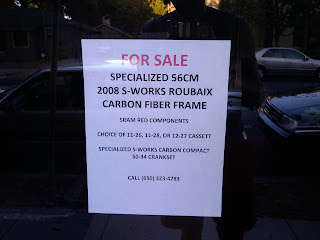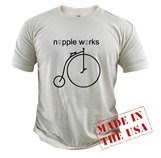I finally bought myself a pair of MUSA Knickers. They had gone off the market for a while but when a coworker's search for authentic fabric handlebar tape brought me back to the Rivendell web site, I saw that they were being sold again. I snapped up a pair, not knowing how long the current run would stay on the shelves. I thought about taking a picture of myself wearing them, but not having a convenient tripod, and also not willing to become a groin and thigh model, I chose to steal one from Rivendell:
 Please keep in mind, I'd never wear them with those sneakers. The fabric is a light nylon that will be wind proof in winter, quick drying in the rain and not too heavy for spring/fall. The only complaint so far is that the fabric is a little slippery on my faux leather WTB saddle. I'm sure Rivendell would tell me to switch to a Brooks cow hide saddle, but I imagine that be even more slippery. They're less technical and also much less expensive than Chrome Shins and also more outdoor worthy than the Sheila Moon Cotton Britches. However, unlike the Britches or Shins, I will definitely not be stylish enough to ride to the Goldsprints in SF with them on. Up until now, I've been wearing a pair of Endura knickers and have an issue with the sizing. Apparently the British are a little thick in the midlands because my size large fits like a size XL. One other benefit, MUSA stands for Made in the USA. While you can feel good about buying products from Chrome or Sheila Moon, I can't say the same for Endura products. Just read these excerpts from the slip of paper that came with my new drawers:
Please keep in mind, I'd never wear them with those sneakers. The fabric is a light nylon that will be wind proof in winter, quick drying in the rain and not too heavy for spring/fall. The only complaint so far is that the fabric is a little slippery on my faux leather WTB saddle. I'm sure Rivendell would tell me to switch to a Brooks cow hide saddle, but I imagine that be even more slippery. They're less technical and also much less expensive than Chrome Shins and also more outdoor worthy than the Sheila Moon Cotton Britches. However, unlike the Britches or Shins, I will definitely not be stylish enough to ride to the Goldsprints in SF with them on. Up until now, I've been wearing a pair of Endura knickers and have an issue with the sizing. Apparently the British are a little thick in the midlands because my size large fits like a size XL. One other benefit, MUSA stands for Made in the USA. While you can feel good about buying products from Chrome or Sheila Moon, I can't say the same for Endura products. Just read these excerpts from the slip of paper that came with my new drawers:










